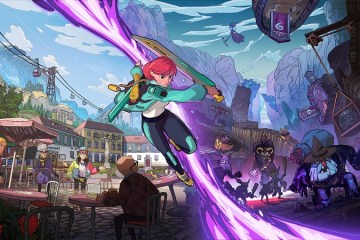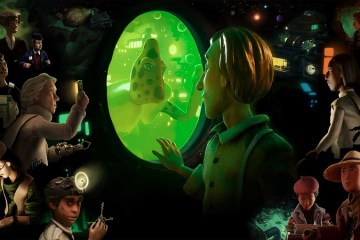The Astronauts is a small, independent studio based in Warsaw, Poland. It was formed in 2012 by the same team of three who had previously founded People Can Fly in 2002 and led to titles such as Painkiller and Bulletstorm. Following Epic Games’ acquisition of People Can Fly and, later, Tencent’s investment into Epic, the leaders wanted to ensure they could continue to independently focus on narrative-driven games. So, they left to chart their own path yet again.
The Astronauts’ first title, The Vanishing of Ethan Carter, was released in 2014 to critical acclaim and broad success. It was then, at The Game Awards in 2017, where they would introduce their follow-up, a very different type of game altogether, Witchfire.
Witchfire is a fantasy, first-person shooter set in an alternative world where witches and magic are very real and very dangerous. You take the role of a “Preyer”; a punishing, witch-hunting arm of the church anointed by the Pope himself whose task is to find and eliminate the witch. The themes were modeled after the 15th century witch-hunts in Europe but have obviously been evolved into dark fantasy.
Witchfire launched into early access in September and, just last week, the first major addition, titled the Ghost Galleon update, was released. With a long list of revisions and additions, how is the game shaping up? Very, very well.
Bewitched
Upon first loading up Witchfire you’re greeted with a dark, haunting theme track and a Bible verse. Immediately you’re put on notice that you’re entering a dark, gothic, fantasy world. And it’s something Witchfire frequently reminds you of.
Currently there are six classes of Preyer to choose from, each with varying stats and initial loadouts. The developers have stated clearly that they are going for the Soulslike approach here, thus giving the player choice in how they’d like to focus the beginning of their journey. I chose the Shadow Preyer, who begins as a ranged-distance shooter and utilizes spells more heavily.
Your class chosen, you begin at the Shrouded Hermitorium with some entry-level training to get you up to speed. This area acts as your home base, and it’s where you can level, change your loadout, evolve the world, and research new items and abilities (more on that shortly).
What’s immediately striking, however, is the environment around you and the associated art direction. Witchfire is an absolutely beautiful game with interesting, artistic details oozing from every crevice. As you approach the church in the area, known as The Sanctuary, it immediately catches your eye. The stained glass windows strew colored light across the stone, a floating mirror and swirling light are inviting yet mysterious, and the shadows feel as though they have real depth. It’s very clear that the team at The Astronauts have a very good handle on Unreal Engine 4 because, for a small team, they make it sing.
Much of this is due to Photogrammetry, which the development team details here. In short, they take hundreds, or even thousands, of pictures of real-life objects and environments, and then have visual artists touch them up for the game. It certainly works, as Witchfire in motion is absolutely stunning. And even in early access, I’ve not experienced any performance issues, either, with extremely fluid gameplay and almost no frame drops.
This beauty carries through to nearly every element of Witchfire. Intricate details abound. When it comes to a developer delivering their creative vision on-screen to the player, you’d be hard pressed to find many examples more appreciable than Witchfire.
Bewitched
As you initially set out, you’ll head to the Scarlet Coast with nary an idea as to what to expect and no quest direction or marker. The game is cryptic by design, and the development team has been clear that this is not a narrative journey filled with cut-scenes. Rather, they want the player to explore and discover on their own while having multiple routes to “success.” It’s a theme I typically enjoy in games, and it’s no different with Witchfire. Being dropped onto a hostile coast with no clear direction of where to go or what I’ll discover is thrilling, and it adds to the mystery and excitement of setting out.
You are provided with a map of the level with a few notable points of interest, but where you go and how you engage with them is entirely up to you. Witchfire, at its core, is best described as a FPS roguelite with Soulslike elements. From run to run, the level layouts don’t change, but item, quest, and enemy locations do in a procedural fashion. This keeps you guessing every time you come back, an aspect that’s further expanded by the new “Gnosis” system.
At the outset of the game, you will begin as Gnosis 1 and, once you meet a few requirements, you can upgrade the world to Gnosis 2 at The Sanctuary (and eventually 3). This not only unlocks a few additional aspects of the game, such as the Trader, but it also evolves the game world. New icons appear on the levels, more advanced enemies begin to appear, and new secrets can be discovered. It’s an effective way to keep the game feeling fresh and is similar in ways to the “World Tier” approach you often see in ARPGs.
The moment to moment gameplay in Witchfire is notably strong for an early access title. Gunplay is fluid, fast, and packs a punch. The feeling of hitting a critical headshot or nailing a perfectly timed combination of a spell, melee, and headshot is exhilarating. The addictive, repeatable gameplay loop in that vein is entirely present already.
That said, combat carries with it a weighted feel. It doesn’t feel like an arcade or twitch shooter. Rather, you have to be thoughtful about your movements, reload timing, and cooldowns. While Witchfire undoubtedly nails the intuitive FPS feel, it manages to integrate a more thoughtful approach in-line with the setting and theme of the game. Should you be too reckless with your stamina usage, you’ll quickly find yourself staring at death’s door.
Wicked Witch of the Coast
As you clear specific areas of the map by wiping out hordes of the witch’s minions, you will be greeted with a couple of stat bonuses from which you can select to unlock for that run. There are bonuses to Firearms, Spells, and “Varia,” which represents overall bonuses such as “Safe Deposit,” which prevents you from losing your volatile witchfire upon death (currency similar to Souls). Taking out mobs and gaining additional abilities then sets you up for the more difficult battles on the map and, eventually, the Familiar: a high-ranking level boss.
Perhaps the most unique aspect of your runs in Witchfire are “Calamities,” which are unique events that build up over time as you make mistakes. Running with the theme of “The Witch is always trying to overpower you,” the calamity meter is ever-present during your runs. Should you take too much damage or even make mistakes like trying to heal without having a healing elixir, the meter will build. Once it fills, a calamity event occurs which adds yet another layer of challenge. At that point your sanity will slowly drain until you either kill certain enemies or destroy the calamity itself.
The developers explain this as not only a system unique to Witchfire, but it is yet another way in which they wanted to put tension on the player knowing that the Witch is always aware of what you’re doing and trying to stop you (you can learn more here). Calamities can be challenging, but they can also be rewarding, a balance that Witchfire strikes well. Should you overcome the calamity, you’ll be granted with additional bonuses and the ability to end your run right then and there, should you so choose.
Witchfire is intended to be a challenging game, and, to that end, the team at The Astronauts have done an excellent job of balancing so far. Early on, your runs will be short, either because you chose them to be or you were quickly overpowered by the Witch’s minions. But each run is an opportunity to progress little by little, and, before you know it, you’ll be exploring the full level, making discoveries, and unlocking new equipment. The familiar elements from Soulslikes and roguelites are well-implemented and keep you continuously itching for just one more run.
Living on a Preyer
Dying or completing a run sends you back to the Shrouded Hermitorium, where you can level up, upgrade your items, and continue your research. Research is a key aspect of Witchfire, and it’s a system I’ve come to genuinely appreciate.
You begin researching new weapons, relics, and upgrades at The Sanctuary and can have two active researches on-going at once. Your research progresses during your runs, and, once complete, you return to unlock it. This enables you to continually unlock new weapons, spells, and relics even when your runs may be going poorly as research progression is never lost. It’s a system that works in parallel to leveling, world upgrades, and gear improvements.
This layering of upgrades makes it feel as though, no matter what you’re doing run to run, you are continually progressing in some form. When combined with the addictive gameplay loop, it’s often difficult to put Witchfire down.
The Witching Year
As Witchfire is currently in early access, only two of the six regions shown on the quest selection screen are available. It still has quite a ways to go until full release, and you can follow its progress directly from the development team here.
But even in its current state of limited scope and content, it’s easy to tell there is something special here. The Astronauts are clearly a talented group of developers, as what they’ve created so far is deeply engaging, creative, and unique. Most of all, it’s polished and well designed. Needing additional content in early access is a far better story than a game that clearly has critical issues that could take months or even years to resolve. And, make no mistake, even in this early state there is still plenty of fun to be had with dozens of hours of gameplay.
I’ll have a lot more to say on Witchfire as its development progresses, along with a final review once the 1.0 version is released. For now, I highly recommend it to anyone who enjoys action-packed roguelites and/or a challenging FPS. As a community, we often discuss the want for more creative games, new IPs, and more support for independent developers. Look no further than Witchfire from The Astronauts.









